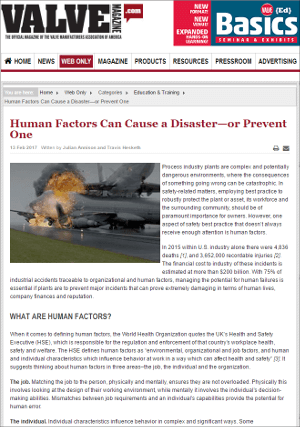Wikipedia defines process safety as focusing on:
In a Valve magazine article, Human Factors Can Cause a Disaster—or Prevent One, Emerson’s Julian Annison and Travis Hesketh highlight the role that human factors play in process safety.…preventing fires, explosions and accidental chemical releases in chemical process facilities or other facilities dealing with hazardous materials such as refineries, and oil and gas (onshore and offshore) production installations.
They open citing these statistics:
With 75% of industrial accidents traceable to organizational and human factors, managing the potential for human failures is essential if plants are to prevent major incidents that can prove extremely damaging in terms of human lives, company finances and reputation.
The United Kingdom’s Health and Safety Executive (HSE) defines human factors as:
…environmental, organizational and job factors, and human and individual characteristics which influence behavior at work in a way which can affect health and safety…
 Julian and Travis describe 3 areas of consideration for human factors:
Julian and Travis describe 3 areas of consideration for human factors:
The job. Matching the job to the person, physically and mentally, ensures they are not overloaded. Physically this involves looking at the design of their working environment, while mentally it involves the individual’s decision-making abilities. Mismatches between job requirements and an individual’s capabilities provide the potential for human error.
The individual. Individual characteristics influence behavior in complex and significant ways. Some characteristics such as personality are fixed and cannot be changed. Others, such as skills and attitudes, may be changed or enhanced.
The organization. Plants need to establish a positive health and safety culture. This needs to promote employee involvement and commitment at all levels, emphasizing that deviation from established health and safety standards is unacceptable.
They share two examples illustrating how human factors led to tragic results. The first involved an airline pilot misinterpreting communications with air traffic control and colliding with another plane. The second involved a routine surgical procedure where a crisis developed and the surgical team did not guidelines. Both examples resulted in loss of life.
Given many of the potentially hazardous environments found within the process industries, human error can lead to disastrous consequences. One area where these human errors can occur are following a shift change. They recommend that plant leadership:
…consider whether these handovers are formalized, whether they can be compromised by time pressures and if their existing procedures could be improved.
Read the article for more areas to consider including new personnel orientation, team culture, empowerment and formalized competency assessment and training.
You can also connect and interact with other process safety and operational experts in the Safety Instrumented Systems and Operate & Maintain groups in the Emerson Exchange 365 community.






